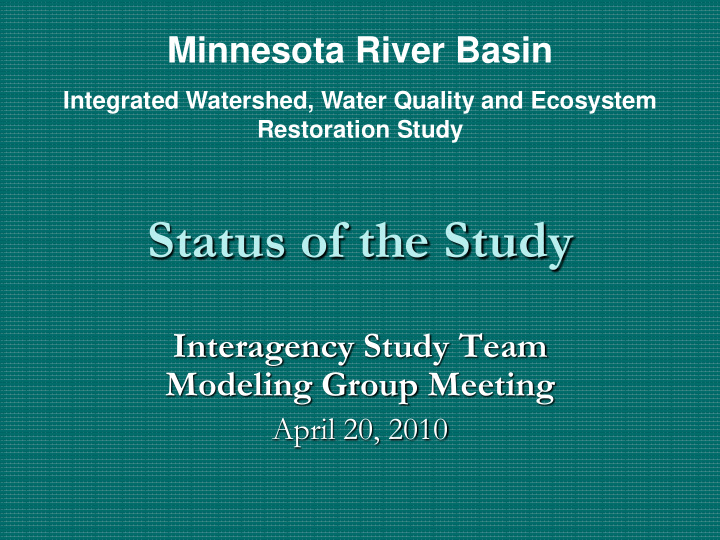



Minnesota River Basin Integrated Watershed, Water Quality and Ecosystem Restoration Study Status of the Study Interagency Study Team Modeling Group Meeting April 20, 2010
Study Purpose • To bring local, state and federal entities together to address problems in the Minnesota River Basin
Objectives • To prepare a plan for watershed management, water quality, and ecosystem restoration • To develop a decision support system
Focus • Flood damage reduction • Ecosystem restoration • Watershed management • Water quality management • Ground water management
Evaluate and Assess Current and future… • Hydrologic regime/basin water budget • Aquatic habitat condition • Sediment transport • Nutrient loading • Watershed condition • Basin social & economic conditions
Outputs • LiDAR • Watershed modeling • Decision support system – Spatially explicit – Technical tools for local use – Developed with stakeholder input • Final report – Basin goals/objectives – Simulated existing & future conditions – Recommended actions
Interagency Study Team • Guides where study goes • Serves as information broker to & from member agencies • Advises Study Coordination Team 7
Technical Groups • Advise the Interagency Study Team on the project… – Public involvement – Plan focus and elements – Decision support system 8
The Planning Group • Identified fundamental planning questions • Will help … – Develop strategic plan for communication and public involvement – Identify ecologically realistic targets and other future scenarios – Identify key users and what they want in a decision support system 9
The Modeling Group • Modeling group will help … – Determine how to apply technical analysis in addressing fundamental project questions • Select, apply and interpret models • Identify and address data collection needs • Scale up to major watersheds and the basin – Translate results into a decision support system 10
Progress to Date • Project management plan • Preliminary modeling discussions • Preliminary outreach/communications discussions • Initial discussion of the form & function of the decision support system • Initial discussion of the fundamental questions the project should answer 11
Minnesota River Watershed Plan (DSS) Technical Analysis Interagency Study Team/Technical Teams Alternatives Scenario Subwatershed Modeling Basin Modeling Development/Analysis Identify Target Future Small Subwatershed Scaling Model Parameters Conditions Modeling to Basin Level Simulate Subwatershed Select Management Hydrology and Materials Simulate River Water Measures Transport – Existing Quality Conditions Simulate Subwatershed Simulated Management Simulate Future Basin Hydrology and Materials Measures and Effects Transport – Reference Conditions 12 (Economic/Ecological) Conditions
2010 Meeting Series (March-May) • Purposes – Come to agreement on the fundamental questions we want the project to answer and how best to do so – Understand what analyses the questions may require – Develop analytical strategies – Select sub-watersheds to represent the basin in addressing the questions 13
2010 Meeting Series (March-May) • March 16 – Planning group – identified fundamental questions that the study should answer • April 20 – Modeling group – identify the most effective tools and ways to answer the questions • May 4 – Interagency Study Team – consider recommendations of two groups; synthesize and identify next steps 14
Next Steps for the Study Team Short Term (2010) • Confirm fundamental questions • Develop the strategy for addressing them – Sub-watershed selection – Model selection – Identify roles/responsibilities for technical analysis – Identify data needs for analysis • Develop communications & public outreach strategies 15
Next Steps for the Study Team Long Term (2011-2012) • Implement communications & public outreach strategies • Develop technical analyses within each sub- watershed to understand possible answers and implications • Identify key users and what they need in a decision support system • Begin to build the DSS 16
Contact Info • John Wells Environmental Quality Board e-mail: john.wells@state.mn.us Phone: 651.201.2475 • Michael Wyatt U.S. Army Corps of Engineers e-mail: michael.d.wyatt@usace.army.mil Phone: 651.290.5216 17
Recommend
More recommend